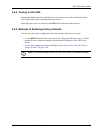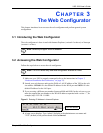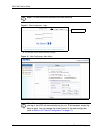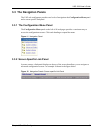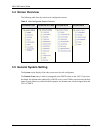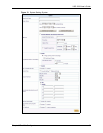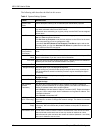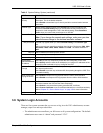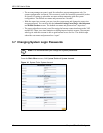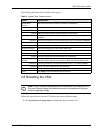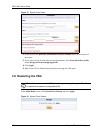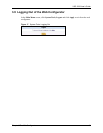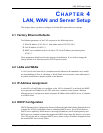
VSG-1200 User’s Guide
46 Chapter 3 The Web Configurator
The following table describes the labels in this screen.
Table 3 System Setting: System
LABEL DESCRIPTION
System/ Host
Name
Enter a descriptive name (up to 32 characters) for identification purposes.
Domain Name Enter the domain name (if you know it) here. If you leave this field blank, the VSG
may obtain a domain name from a DHCP server.
The domain name entered by you is given priority over the DHCP server assigned
domain name.
Date/Time To manually set the system date and time, select the appropriate choices from the
Date and Time drop-down list boxes.
Click Get from my Computer to set the time and date on the VSG to be the same
as the computer that you use to configure the VSG.
If you select Use NTP (Network Time Protocol) Time Server option and set the
necessary fields, you can click Get from NTP Server to update the time and date
on the VSG from the NTP time server.
Use NTP (Network
Time Protocol)
Time Server
Select this option to have the VSG get the date and time information from a time
server.
Server IP/ Domain
Name
Enter the IP address or the domain name of the time server. Check with your ISP/
network administrator if you are unsure of this information.
Time Zone Select your time zone from the drop-down list box. This will set the time difference
between your time zone and Greenwich Mean Time (GMT).
Update Time Enter the number of hours between updates.
Daylight Savings Select this option if you use daylight savings time.
Daylight saving is a period from late spring to early fall when many countries set
their clocks ahead of normal local time by one hour to give more daytime light in
the evening.
Start Date Specify the month and day that your daylight-savings time starts on if you select
Daylight Savings.
End Date Specify the month and day that your daylight-savings time ends on if you select
Daylight Savings.
NAT (Network
Address
Translation)
NAT (RFC 1631) is the translation of the IP address of a host in a packet, for
example, the source address of an outgoing packet, used within one network to a
different IP address known within another network.
Select Enable to activate Network Address Translation (NAT). Enable this feature
to set your VSG to map multiple local IP addresses to one global IP address. This
is the default selection.
Select Disable to deactivate NAT.
IP Plug and Play
(iPnP Technology)
Select this option to allow plug-and-play Internet access which means that
subscribers do not have to change their network settings. This feature is activated
by default.
DNS Fake IP
Reply
Select this option to assign private IP address to a network device (such as the e-
mail server). NAT will translate the private IP address to the public IP address on
the WAN.
User Session Limit You can set the VSG to limit the number of sessions each user can use at a time.
Select Unlimited to allow each user to use any number of sessions at a time.
Select the second option and enter the number of sessions (between 1 and 1024)
each user is allowed to use at a time.




